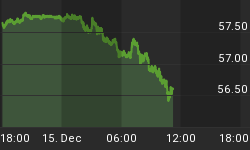In the discussion about whether the economy is exhibiting "inflationary tendencies" or "deflationary tendencies," I find that many, many observers grow confused by the fact that we measure prices in dollars, which are themselves subject to changes in relative value due to supply and demand.
It helps to forget about dollars as the unit of measure. Just because it says "One Dollar" does not mean that it is an ever-fixed mark. With apologies to Shakespeare, dollars are not the star to every wandering bark, whose worth's unknown although its dollar price be taken.[¹] There are two ways to look at the "inflation/deflation" debate. Depending on which one you are referring to, deflationary tendencies are not inconsistent with price inflation, and price inflation is not inconsistent with deflationary tendencies.
One is the question of dollar price; and here we are mainly concerned with the supply of dollars and the number of times they are spent, compared to the amount of stuff there is to buy. More dollars chasing the same goods and services imply higher prices. Of course, this is just another way of stating the monetarist equation: P ≡ MV/Q. This is an identity and true by definition. Moreover, it is true in practice: rapid money growth over some moderate length of time always corresponds with rapid deterioration in the purchasing power of the money unit - in other words, inflation. At least, we have no examples of (a) extremely high money growth without high inflation, or (b) extremely high inflation without high money growth.
But this is not the same discussion as saying that "the aging demographic means we will have deflation," as many economists will have it (for example, in a recent Out of the Box offered by Mauldin Economics here). But deflation, in that sense, can still happen: if you have fewer workers making the same amount of GDP, then goods (and services) prices will fall relative to wages, which would be deflation the way we typically mean it if the overall price level was otherwise unchanged. However, if the money supply increases by a factor of 10, then nominal prices will increase no matter what else is going on. It may be, though, that in this case wages will increase slightly more than prices, so that there will be "deflation" in the unitless sense.
So, these are not inconsistent statements: (a) there will be increasing inflation next year, and (b) large amounts of private debt and demographic "waves" around the world are a deflationary force. The resolution to the seeming inconsistency is that (b) causes downward pressure on certain prices relative to other prices or, if you ignore the unit of exchange, it causes downward pressure in the ratio of one good that can be exchanged for another. Yet at the same time (a) implies that the overall increase in output in goods and services will be outstripped by the number of dollars spent on them, driving prices higher.
So you should cheer for the sort of deflation caused by the demographic wave that Harry Dent is talking about in the John Mauldin Out-of-the-Box piece. At least, you should cheer for it if you are still earning wages. But do not confuse that concept with the notion that prices in dollar terms will fall. That is wholly different, and unless central banks screw up pretty badly it is not going to happen. Indeed, despite all of the so-called "deflationary tendencies" - most of which I agree are important - I believe prices are going to rise in dollar terms and in fact they are going to rise at increasing rates (higher inflation) over the next few years.
[1] See Sonnet 116, in case you missed out on a liberal arts education and don't get the reference!
















